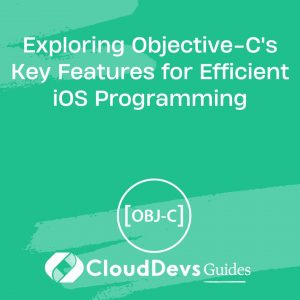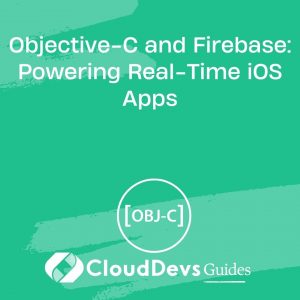Exploring Objective-C’s Key Features for Efficient iOS Programming
When it comes to developing robust and efficient iOS applications, Objective-C has been a go-to language for many developers. Its rich set of features and integration with Apple’s frameworks make it a powerful tool for building applications that run smoothly on iOS devices. In this blog post, we will delve into Objective-C’s key features that contribute to efficient iOS programming. From its dynamic nature to its powerful runtime system, we’ll explore the aspects that make Objective-C a top choice for iOS developers.
1. The Dynamic Nature of Objective-C
Objective-C’s dynamic nature is one of its standout features, providing developers with flexibility and extensibility in their code. Let’s explore some of the key elements of this dynamic nature.
1.1 Dynamic Typing:
Objective-C allows for dynamic typing, meaning that the type of an object can be determined at runtime. This enables developers to work with generic objects using the id type and perform operations on them dynamically. Here’s an example:
objective id myObject = @"Hello, World!"; [myObject length]; // Calling the 'length' method on a generic object
1.2 Dynamic Binding:
Objective-C utilizes dynamic binding, which allows method calls to be resolved at runtime based on the actual object’s class. This enables developers to leverage polymorphism and message passing in their code. For instance:
objective UIView *view = [[UIView alloc] init]; id subview = [[UILabel alloc] init]; [view addSubview:subview]; // Dynamic binding resolves the appropriate 'addSubview' method
2. Object-Oriented Programming in Objective-C
Objective-C is an object-oriented programming language that emphasizes message passing between objects. This paradigm facilitates building modular and reusable code. Let’s dive into some key concepts related to object-oriented programming in Objective-C.
2.1 Classes and Objects:
Objective-C uses classes to define objects, which are instances of those classes. Classes encapsulate both data (instance variables) and behavior (methods). Here’s an example of defining a class and creating objects:
objective
@interface Person : NSObject
@property (nonatomic, strong) NSString *name;
- (void)introduce;
@end
@implementation Person
- (void)introduce {
NSLog(@"My name is %@", self.name);
}
@end
Person *person = [[Person alloc] init];
person.name = @"John";
[person introduce]; // Outputs: "My name is John"
2.2 Inheritance and Polymorphism:
Objective-C supports inheritance, allowing classes to inherit properties and methods from a superclass. This promotes code reuse and modularity. Polymorphism, on the other hand, enables objects of different classes to respond to the same message. Here’s an example:
objective
@interface Animal : NSObject
- (void)sound;
@end
@implementation Animal
- (void)sound {
NSLog(@"Generic animal sound");
}
@end
@interface Cat : Animal
@end
@implementation Cat
- (void)sound {
NSLog(@"Meow");
}
@end
Animal *animal = [[Cat alloc] init];
[animal sound]; // Outputs: "Meow"
3. Objective-C’s Runtime System
Objective-C’s runtime system is a powerful component that allows dynamic method dispatch, introspection, and other advanced features. Understanding the runtime system can greatly enhance your capabilities as an Objective-C developer. Let’s explore some key aspects.
3.1 Method Swizzling:
Method swizzling is a technique that allows developers to exchange the implementation of methods at runtime. This can be useful for extending or modifying the behavior of existing classes. Here’s an example:
objective
@implementation NSString (Custom)
- (NSString *)reversedString {
NSMutableString *result = [NSMutableString string];
for (NSInteger i = self.length - 1; i >= 0; i--) {
[result appendString:[NSString stringWithFormat:@"%C", [self characterAtIndex:i]]];
}
return result;
}
@end
NSString *originalString = @"Hello";
NSString *reversedString = [originalString reversedString];
NSLog(@"%@", reversedString); // Outputs: "olleH"
3.2 Dynamic Method Resolution:
Objective-C’s runtime system allows developers to dynamically resolve methods that may not exist at compile-time. This feature can be leveraged to provide default implementations or handle method calls dynamically. Here’s an example:
objective
@implementation MyClass
+ (BOOL)resolveInstanceMethod:(SEL)selector {
if (selector == @selector(unknownMethod)) {
class_addMethod([self class], selector, (IMP)dynamicMethodImplementation, "v@:");
return YES;
}
return [super resolveInstanceMethod:selector];
}
void dynamicMethodImplementation(id self, SEL _cmd) {
NSLog(@"Dynamic method called");
}
@end
MyClass *myInstance = [[MyClass alloc] init];
[myInstance unknownMethod]; // Outputs: "Dynamic method called"
Conclusion:
Objective-C’s key features make it a powerful language for efficient iOS programming. Its dynamic nature, object-oriented programming capabilities, and runtime system enable developers to build flexible and extensible applications. By leveraging these features, you can unlock the full potential of Objective-C and create robust iOS applications that meet the highest standards. So, dive into Objective-C and take advantage of its rich features to enhance your iOS development skills. Happy coding!
Table of Contents









